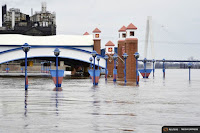President Obama's plan to safeguard the nation from increasing flood risk due to climate change was quietly green-lighted by Congress last month in the 2016 omnibus budget bill.
It marks one of the only actions Congress took on global warming in all of 2015, and it came as a surprise considering the longstanding opposition from Republicans. And it is a critical one, several policy experts said. It will impact billions of dollars of federally funded construction projects across the country, from highways and bridges to hospitals and housing complexes, at a time when flooding in the U.S. is getting worse every year because of climate change.
"The policy illustrates the awareness that we should not build things that are vulnerable to flooding now or in the future," said Rob Moore, a policy analyst and director of the Natural Resources Defense Council's Water and Climate Team. "That may not seem like a revolutionary idea, but unfortunately it is. We have a long history of building things that easily get soggy."
Obama's plan, executive order No. 13960, mandates that all federally funded projects located in a floodplain be built higher and stronger than previously required. It is the first update to the Federal Flood Risk Management Standard since the policy was created 38 years ago. It applies to both new construction and rebuilding following a disaster.
Under the old standards, enacted by President Jimmy Carter in 1977, buildings in the floodplain had to be elevated to the 100-year flood level. Under Obama's executive order, buildings must now be elevated 2 or 3 feet above the 100-year flood level (the higher standard is for "critical" infrastructure, like hospitals), or at the 500-year flood level. A third option is for federal agencies to analyze future climate change scenarios and build according to those projections, such as for sea level rise or expected heavier rain events.
Flooding accounts for approximately 85 percent of all disaster declarations in the U.S. and caused more than $260 billion in damages between 1980 and 2013. There were three billion-dollar-plus flooding disasters in 2015, and thousands of homes and businesses along the Mississippi River and its tributaries rang in the New Year under water after unusual heavy winter rains.
"Recent flood events are putting more attention on this very matter," said Roy Wright, who leads disaster risk-reduction efforts for the Federal Emergency Management Agency. "We need to build higher and stronger than we used to."
Scientists say the problem will only get worse with climate change as seas rise and warm temperatures fuel stronger rain events. Heavy rainstorms and flooding that historically happened once in 20 years are forecast to occur as frequently as every 5 to 15 years by the second half of this century, according to the National Climate Assessment.
Read more at Congress Actually Dealt with Climate Change in the 2016 Budget Bill. Really.

No comments:
Post a Comment